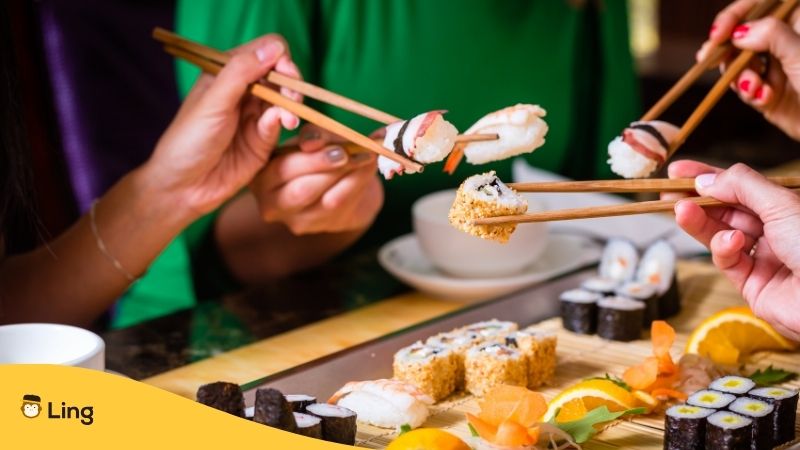As a long-time expat living here in Tokyo, one of the things you won’t see me do is walking while eating or 食 べ 歩き or Tabearuki in Japanese language. I know this might come as a surprise, though – because while eating on the go is commonplace in many major cities around the world, here in Japan, it is actually still considered quite abnormal by most locals.
As a guest in this country, I always aim to adhere to local customs as much as possible as a sign of respect. This includes avoiding tabearuki even when grabbed by hunger pangs away from a table! Culturally in Japan, food is meant to be savored slowly and intentionally – not scooped up hastily in passing.
Ready to learn more? Let’s get to know this aspect of Japanese culture and some useful phrases in the Japanese language in this post.
Table of Contents

What Is Tabearuki In Japanese?
This quirky word is a combination of two verbs in Japanese: “taberu” meaning to eat, and “aruku” for to walk. So literally translated, it means chowing down on something while walking along – simple as that!
I know this probably sounds completely normal to those of you coming from places where grabbing a quick snack on your commute is the norm. But here in Japan, as we discussed, it’s that unwritten rule that catches a lot of visitors off guard. Even I was a bit puzzled when I first moved here years back and noticed how universal finding a place to pause and sit was before diving into meals or munchies.
Over my decade living among locals, I’ve had some fascinating conversations about the surprisingly complex cultural aversions to tabearuki. Beyond just coming off as messy or rushed, some insightful Japanese friends have shared interesting historical perspectives on why walking while eating strikes a chord.
For instance, some trace it back to ancient times in Japan when walking while snacking was seen as a sign of poverty – like you couldn’t even afford a proper place to sit, let alone feed yourself! Even as societies modernized with busy urban workforces always pressed for time, that view of tabearuki as being lower class persisted.
Then there’s the argument that eating immersed in travel distracts from the flavors and artistry of carefully prepared cuisine. It ties into the value placed on mindfulness and being fully present during meals – even quick ones!
Why Is Tabearuki Frowned Upon In Japan?
So now that you know the literal translation and backstory on tabearuki, you’re probably still wondering… why exactly do Japanese folks frown so heavily on eating while walking around? I had the same question when I first moved here too!
Beyond just coming across as messy or rushed, my local friends have shared some eye-opening cultural perspectives on why walking and eating strikes a chord for most Japanese people. It ties back to beliefs about both cleanliness and the artistry of cuisine here.
Cleanliness
First, Japan values public cleanliness to an extent you don’t see in most other countries. From routine neighborhood cleaning campaigns to providing ubiquitous street trash cans, keeping communities clutter and spill-free is serious business! So you can imagine food or crumbs scattered by some inconsiderate tabearuki offender could cause great offense.
Even as an avid eater myself, I have to admit after living here awhile you notice and appreciate the lack of food stains on metro seats or sidewalk gum marks! It keeps the dining experience smooth and enjoyable from start to clean finish for all.
Appreciating The Food
Then there is the meticulous, artistic nature of Japanese cooking itself, from flavorful yet simple onigiri rice balls to elegant multi-course kaiseki that takes hours to create and mere minutes for diners to devour!
Chefs put their heart and soul into crafting the perfect bite. So what self-respecting food fan could bear to gulp that down in passing while distracted by walking and sights instead of properly admiring each nuance? I certainly couldn’t!
Once I learned to slow down and let the aromas, textures, and tastes of the incredible meals here inhabit my senses one by one, there was just no going back to thoughtlessly eating on the run. Try it yourself – tabearuki may be efficient, but mindful dining the Japanese way is sheer bliss!

Where To Enjoy Tabearuki In Japan
Alright, so at this point, you hopefully understand why locals deeply frown upon Tabearuki, and you respect the cultural aversion to eating on the go here in Japan. But I also don’t want to make enjoying incredible grab-and-go street eats seem impossible as a visitor!
The key is knowing the right times and situations where pausing to appreciate flavorful portable foods is seen as more permissible, though still not necessarily encouraged. Large festivals and night markets are good examples where you’ll spot plenty of folks indulging in food stalls and trucks on foot.
The same goes for bar-hopping izakaya alleyways or busy train station food courts during rush hour dinner times – counter space fills up fast! As long as you avoid major walkways, stepping to the side to consume something handheld isn’t completely shunned.
But I still highly recommend taking a minute to park yourself on one of the numerous public benches dotting city streets whenever possible while snacking. Trash receptacles are usually right nearby, making for easy, clean disposal, too – the best of both worlds!
Quick pro trip: Seek out outdoor udon or soba noodle carts where seating is part of the experience!
Easy Japanese Phrases For Asking Where To Eat
Alright, we’ve covered quite a bit about Japan’s fascinating tabearuki culture at this point! But you’re probably still wondering with all the incredible food temptations around every corner – how and where should visitors actually sit down to enjoy meals respectfully? Great question!
Luckily, one fantastic thing about Japanese culture is how happy locals tend to be helping tourists out, especially for anything food-related! If you’re exploring an intriguing new neighborhood and get tempted by aromas wafting from street carts or restaurant doors but aren’t sure where to properly stop first – just ask!
It can feel awkward at times with the language barrier. But from my decade of travel here, I’ve learned some very handy, easy Japanese phrases that have served me well for finding acceptable spots to indulge. And the appreciation when you make an effort goes a long way!
For example, simply saying:
Sumimasen, tabete ii tokoro arimasu ka?” (すみません、食べていいところありますか?)
Is a very polite way to ask “Excuse me, is there somewhere good around here to sit and eat?”
You can also get more specific if you have a certain craving, like:
“Rāmen o taberareru tokoro o oshiete kudasai.” (ラーメンを食べられるところを教えて下さい。)
Which means “Please tell me where I can eat ramen.”
See, being a respectful and linguistically sensitive traveler seeking guidance opens lots of doors! And appreciative shop owners or pedestrians will point you towards appropriate counters, tables, or restaurant seats nearby in no time.
Ready To Visit Japan?
After all this insider knowledge on tabearuki culture and etiquette, you’re probably feeling ready to hop a flight straight to Japan’s shores and dive mouth-first into the amazing food scene here! Can’t say I blame you.
Just be sure to remember the cultural lessons around savoring this incredible cuisine slowly while seated. I know it can be painfully tempting to walk, gaze at mesmerizing temples, and nibble local delicacies all at once. But respect for enduring traditions here will reward you even more richly than a moment of convenience ever could!
If you want to really level up on preparing your tastebuds AND cultural knowledge of food in Japan before arriving, I highly recommend downloading the Ling app! Their fun bite-sized Japanese lessons gave me a big leg up on navigating dining etiquette and ordering confidence before touching down in Tokyo.
Give Ling a try now!


































































